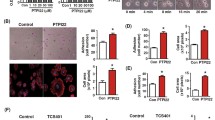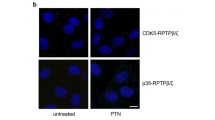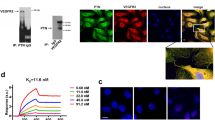Abstract
Vasodilator-stimulated phosphoprotein (VASP), an important substrate of PKA, plays a critical role in remodeling of actin cytoskeleton and actin-based cell motility. However, how PKA accurately transfers extracellular signals to VASP and then how phosphorylation of VASP regulates endothelial cell migration have not been clearly defined. Protein kinase A anchoring proteins (AKAPs) are considered to regulate intracellular-specific signal targeting of PKA via AKAP-mediated PKA anchoring. Thus, our study investigated the relationship among AKAP anchoring of PKA, PKA activity, and VASP phosphorylation, which is to clarify the exact role of VASP and its upstream regulatory mechanism in PKA-dependent migration. Our results show that chemotactic factor PDGF activated PKA, increased phosphorylation of VASP at Ser157, and enhanced ECV304 endothelial cell migration. However, phosphorylation site-directed mutation of VASP at Ser157 attenuated the chemotactic effect of PDGF on endothelial cells, suggesting phosphorylation of VASP at Ser157 promotes PKA-mediated endothelial cell migration. Furthermore, disrupting PKA anchoring to AKAP or PKA activity significantly attenuated the PKA activity, VASP phosphorylation, and subsequent cell migration. Meanwhile, disrupting PKA anchoring to AKAP abolished PDGF-induced lamellipodia formation and special VASP accumulation at leading edge of lamellipodia. These results indicate that PKA activation and PKA-mediated substrate responses in VASP phosphorylation and localization depend on PKA anchoring via AKAP in PDGF-induced endothelial cell migration. In conclusion, AKAP anchoring of PKA is an essential upstream event in regulation of PKA-mediated VASP phosphorylation and subsequent endothelial cell migration, which contributes to explore new methods for controlling endothelial cell migration related diseases and angiogenesis.





Similar content being viewed by others
References
Patti G, Melfi R, Di Sciascio G (2005) The role of endothelial dysfunction in the pathogenesis and in clinical practice of atherosclerosis. Current evidences. Recent Prog Med 96(10):499–507
Walsh DA (2007) Pathophysiological mechanisms of angiogenesis. Adv Clin Chem 44:187–221
Ridley AJ, Schwartz MA, Burridge K, Firtel RA, Ginsberg MH, Borisy G et al (2003) Cell migration: integrating signals from front to back. Science 302(5651):1704–1709
Small JV, Stradal T, Vignal E, Rottner K (2002) The lamellipodium: where motility begins. Trends Cell Biol 12(3):112–120
Kwiatkowski AV, Gertler FB, Loureiro JJ (2003) Function and regulation of Ena/VASP proteins. Trends Cell Biol 13(7):386–392
Sechi AS, Wehland J (2004) ENA/VASP proteins: multifunctional regulators of actin cytoskeleton dynamics. Front Biosci 9:1294–1310
Liu K, Li L, Nisson PE, Gruber C, Jessee J, Cohen SN (1999) Reversible tumorigenesis induced by deficiency of vasodilator-stimulated phosphoprotein. Mol Cell Biol 19(5):3696–3703
Reinhard M, Jarchau T, Walter U (2001) Actin-based motility: stop and go with Ena/VASP proteins. Trends Biochem Sci 26(4):243–249
Smolenski A, Bachmann C, Reinhard K, Honig-Liedl P, Jarchau T, Hoschuetzky H et al (1998) Analysis and regulation of vasodilator-stimulated phosphoprotein serine 239 phosphorylation in vitro and in intact cells using a phosphospecific monoclonal antibody. J Biol Chem 273(32):20029–20035
Krause M, Dent EW, Bear JE, Loureiro JJ, Gertler FB (2003) Ena/VASP proteins: regulators of the actin cytoskeleton and cell migration. Annu Rev Cell Dev Biol 19:541–564
Loureiro JJ, Rubinson DA, Bear JE, Baltus GA, Kwiatkowski AV, Gertler FB (2002) Critical roles of phosphorylation and actin binding motifs, but not the central proline-rich region, for Ena/vasodilator-stimulated phosphoprotein (VASP) function during cell migration. Mol Biol Cell 13(7):2533–2546
Harbeck B, Huttelmaier S, Schluter K, Jockusch BM, Illenberger S (2000) Phosphorylation of the vasodilator-stimulated phosphoprotein regulates its interaction with actin. J Biol Chem 275(40):30817–30825
Eckert RE, Jones SL (2007) Regulation of VASP serine 157 phosphorylation in human neutrophils after stimulation by a chemoattractant. J Leukoc Biol 82(5):1311–1321
Aszodi A, Pfeifer A, Ahmad M, Glauner M, Zhou XH, Ny L et al (1999) The vasodilator-stimulated phosphoprotein (VASP) is involved in cGMP- and cAMP-mediated inhibition of agonist-induced platelet aggregation, but is dispensable for smooth muscle function. EMBO J 18(1):37–48
Bear JE, Loureiro JJ, Libova I, Fassler R, Wehland J, Gertler FB (2000) Negative regulation of fibroblast motility by Ena/VASP proteins. Cell 101(7):717–728
Howe AK (2004) Regulation of actin-based cell migration by cAMP/PKA. Biochim Biophys Acta 1692(2–3):159–174
Feliciello A, Gottesman ME, Avvedimento EV (2001) The biological functions of A-kinase anchor proteins. J Mol Biol 308(2):99–114
Colledge M, Scott JD (1999) AKAPs: from structure to function. Trends Cell Biol 9(6):216–221
Beene DL, Scott JD (2007) A-kinase anchoring proteins take shape. Curr Opin Cell Biol 19(2):192–198
Michel JJ, Scott JD (2002) AKAP mediated signal transduction. Annu Rev Pharmacol Toxicol 42:235–257
Diviani D, Scott JD (2001) AKAP signaling complexes at the cytoskeleton. J Cell Sci 114(Pt 8):1431–1437
Hundsrucker C, Rosenthal W, Klussmann E (2006) Peptides for disruption of PKA anchoring. Biochem Soc Trans 34(Pt 4):472–473
Bear JE, Svitkina TM, Krause M, Schafer DA, Loureiro JJ, Strasser GA et al (2002) Antagonism between Ena/VASP proteins and actin filament capping regulates fibroblast motility. Cell 109(4):509–521
Trichet L, Sykes C, Plastino J (2008) Relaxing the actin cytoskeleton for adhesion and movement with Ena/VASP. J Cell Biol 181(1):19–25
Bailly M (2004) Ena/VASP family: new partners, bigger enigma. Dev Cell 7(4):462–463
Krause M, Bear JE, Loureiro JJ, Gertler FB (2002) The Ena/VASP enigma. J Cell Sci 115(Pt 24):4721–4726
Niebuhr K, Ebel F, Frank R, Reinhard M, Domann E, Carl UD et al (1997) A novel proline-rich motif present in ActA of Listeria monocytogenes and cytoskeletal proteins is the ligand for the EVH1 domain, a protein module present in the Ena/VASP family. EMBO J 16(17):5433–5444
Laurent V, Loisel TP, Harbeck B, Wehman A, Grobe L, Jockusch BM et al (1999) Role of proteins of the Ena/VASP family in actin-based motility of Listeria monocytogenes. J Cell Biol 144(6):1245–1258
Schlegel N, Burger S, Golenhofen N, Walter U, Drenckhahn D, Waschke J (2008) The role of VASP in regulation of cAMP- and Rac 1-mediated endothelial barrier stabilization. Am J Physiol Cell Physiol 294(1):C178–C188
Comerford KM, Lawrence DW, Synnestvedt K, Levi BP, Colgan SP (2002) Role of vasodilator-stimulated phosphoprotein in PKA-induced changes in endothelial junctional permeability. FASEB J 16(6):583–585
Rawe VY, Ramalho-Santos J, Payne C, Chemes HE, Schatten G (2004) WAVE1, an A-kinase anchoring protein, during mammalian spermatogenesis. Hum Reprod 19(11):2594–2604
Snyder EM, Colledge M, Crozier RA, Chen WS, Scott JD, Bear MF (2005) Role for A kinase-anchoring proteins (AKAPs) in glutamate receptor trafficking and long term synaptic depression. J Biol Chem 280(17):16962–16968
Dodge-Kafka KL, Langeberg L, Scott JD (2006) Compartmentation of cyclic nucleotide signaling in the heart: the role of A-kinase anchoring proteins. Circ Res 98(8):993–1001
Tasken K, Stokka AJ (2006) The molecular machinery for cAMP-dependent immunomodulation in T-cells. Biochem Soc Trans 34(Pt 4):476–479
Huang Z, Somanath PR, Chakrabarti R, Eddy EM, Vijayaraghavan S (2005) Changes in intracellular distribution and activity of protein phosphatase PP1gamma2 and its regulating proteins in spermatozoa lacking AKAP4. Biol Reprod 72(2):384–392
Gaillard AR, Fox LA, Rhea JM, Craige B, Sale WS (2006) Disruption of the A-kinase anchoring domain in flagellar radial spoke protein 3 results in unregulated axonemal cAMP-dependent protein kinase activity and abnormal flagellar motility. Mol Biol Cell 17(6):2626–2635
Howe AK, Baldor LC, Hogan BP (2005) Spatial regulation of the cAMP-dependent protein kinase during chemotactic cell migration. Proc Natl Acad Sci USA 102(40):14320–14325
Howe AK, Hogan BP, Juliano RL (2002) Regulation of vasodilator-stimulated phosphoprotein phosphorylation and interaction with Abl by protein kinase A and cell adhesion. J Biol Chem 277(41):38121–38126
Hasegawa Y, Murph M, Yu S, Tigyi G, Mills GB (2008) Lysophosphatidic acid (LPA)-induced vasodilator-stimulated phosphoprotein mediates lamellipodia formation to initiate motility in PC-3 prostate cancer cells. Mol Oncol 2(1):54–69
Price CJ, Brindle NP (2000) Vasodilator-stimulated phosphoprotein is involved in stress-fiber and membrane ruffle formation in endothelial cells. Arterioscler Thromb Vasc Biol 20(9):2051–2056
Acknowledgments
This study was supported by grants from National Natural Science Foundation of China (Grant No. 30470680). Recombinant plasmids (VASP-WT and Ser157 mutant VASP-S157A) are kindly gifts from the Institute of Clinical Biochemistry and Pathobiochemistry, Wurzburg University, Germany.
Author information
Authors and Affiliations
Corresponding author
Rights and permissions
About this article
Cite this article
Zhang, D., Ouyang, J., Wang, N. et al. Promotion of PDGF-induced endothelial cell migration by phosphorylated VASP depends on PKA anchoring via AKAP. Mol Cell Biochem 335, 1–11 (2010). https://doi.org/10.1007/s11010-009-0234-y
Received:
Accepted:
Published:
Issue Date:
DOI: https://doi.org/10.1007/s11010-009-0234-y




